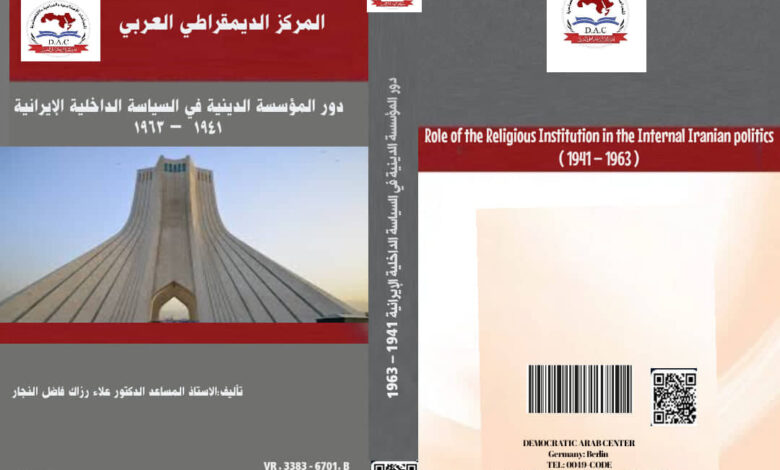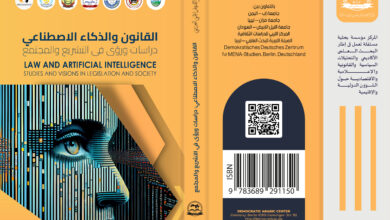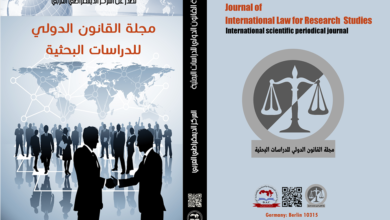دور المؤسسة الدينية في السياسة الداخلية الإيرانية 1941 – 1963
Role of the Religious Institution in the Internal Iranian politics 1941 – 1963

تأليف : د. علاء رزاك فاضل النجار – استاذ العلاقات الدولية – جامعة البصرة – العراق
نسخة “pdf”-
دور المؤسسة الدينية في السياسة الداخلية الإيرانية 1941 – 1963
الطبعة الأولى “2022″ –من كتاب: – دور المؤسسة الدينية في السياسة الداخلية الإيرانية 1941 – 1963
جميع حقوق الطبع محفوظة #المركز_الديمقراطي_العربي ولا يسمح بإعادة إصدار هذا الكتاب أو اي جزء منه أو تخزينه في نطاق إستعادة المعلومات أو نقله بأي شكل من الأشكال، دون إذن مسبق خطي من الناشر .
تقديم:
اهتمت الدراسة بتوضيح دور رجال الدين في تاريخ إيران المعاصر من عام 1941 إلى عام 1963. وتكونتمن مقدمة وثلاثة فصول وخاتمة. تناولت المقدمة ظهور رجال الدين في العهد الصفوي في إيران والامتيازات التي قدمها الشاه في ذلك الوقت لهم مما جعلهم مؤثرين جداً في حياة إيران. ونتيجة لذلك ، بدأوا في التدخل في جميع الشؤون السياسية والاقتصادية والاجتماعية للدولة. وتدريجياً ، سيطروا على الشاه نفسه. واستمر ذلك حتى بعد سقوط الدولة الصفوية ومجيئ الدولتين الأفشاريةوالزندية. ونتيجة لذلك، ساد تأثير رجال الدين في إيران وامتد إلى العالم الإسلامي. ومع ذلك، حدث تغيير عندما حاول ملوك الدولة القاجارية الحد من تأثير رجال الدين؛ لكن كل ذلك كان عبثاً. وأخيراً، عندما جاءت عائلة بهلوي لحكم إيران عام 1925، وأصبح رضا شاه بهلوي الحاكم، تمكن من تقليص دورهموتهميشه في السياسة الإيرانية.
خصص الفصل الأول لدراسة دور رجال الدين في السياسة الداخلية في ايران منذ تتويج محمد رضا بهلوي حاكماً بعد والده. اذ عاد رجال الدين لحكمهم ونفوذهم في المجتمع الإيراني من خلال انتمائهم في الأحزاب والتنظيمات السياسية ومشاركتهم في التظاهرات. ومع ذلك ، استعادت الحكومة قوتها في نهاية الحرب العالمية الثانية وأدى ذلك إلى خلافات وصدامات بين رجال الدين والنظام. وزاد التوتر بعد محاولة اغتيال الشاه، الذي اتهم به اية الله الكاشاني ونفيه خارج البلاد. ثم تطور دور رجال الدين في بداية الخمسينيات من خلال قيادة القوى الوطنية وتأميم النفط الإيراني.
نافش الفصل الثاني دور رجال الدين في عهد حكومة مصدق. اذ ان بعض رجال الدين وقفوا ضد مصدق وحكومته لكن معظمهم ساندوه بكل الوسائل والإمكانيات. وبعد ان خلع الشاه مصدق وعين أحمد قوام رئيساً للوزراء بدلاً منه،لم يقبل رجال الدين بذلك ، وقادوا ثورة في 21 تموز 1952 أسفرت عن عودة مصدق إلى منصبه.
وبعد العودة ، تبنى مصدق نهجاً مختلفاًتمثلبتقربه من الشيوعيين ، وفرض بعض القوانين العلمانية ، ورفض إلغاء بعضها الآخر. وقد أدى ذلك إلى خلافات مع رجال الدين وفقد مصدق سيطرته على البلاد وأطيح به في النهاية بانقلاب في 19 اب 1953، كانت الولايات المتحدة الأمريكية وراءها.
ويتناول الفصل الثالث موقف رجال الدين من حكومة زاهدي ، وكيف انقسموا كمعارضين ومؤيدين ومحاولة الحكومة كسب تأييد الكاشاني وجمعية فدائيي الإسلام. ومع اقتراب الانتخابات البرلمانية، عملت الحكومة على فوز مرشحيها، وهكذا توحد رجال الدين في معارضتهم للحكومة، وازدادت الأمور سوءا وزاد التوتر بين النظام ورجال الدين عندما استؤنفت العلاقة مع بريطانيا وعقد اتفاق مع اتحاد النفط وانتهت جهود تأميم النفط الايراني. كما رفض رجال الدين انضمام الحكومة إلى التحالفات الغربية ووقع صدام مباشر مع حكومة حسين علاء. ثم قامت الحكومة بالعديد من الأعمال التي زادت من عدم الرضا والانزعاج بين رجال الدين مثل: دعم المجموعة البهائية ، وتأسيس السافاك. وعلى الرغم من ان الحكومة الايرانية خففت نسبياً من تشددها عندما سمحت للأحزاب السياسية والتنظيمات بأداء مهامها،وبدأ العديد من رجال الدين في المشاركة مرة أخرى في الحياة السياسية، الا ان هذه السياسة تغيرت عندما توفي البروجردي والكاشاني، اذ فرضت قوانين جديدة تتعارض مع التعليمات الدينية،وأدى ذلك إلى عودة التوتر والصدام بين السلطات الايرانية والمؤسسة الدينية مرة أخرى.
Ala’a Razzaq Fadhil Al – Najjar
Abstract
The Three entities of Clergymen , the army and the Bazar have their own effect on all events in Iran . This study is concerned with clarifying the role of the clergymen during the contemporary history of Iran from 1941 to 1963 .Thus , this study completes the efforts of the other studies that investigated the effect of this group on Iranian politics and the reflection of that in the region and the world .
The rule of the clergymen in Iran started since the beginning of the Safawi state . They participated and had their ow position towards revolts and revolutions to the extent that they were able to dethrone the Shah himself and inaugurate another . During the period ,the clergymen tried to exercise their power on Iran and were able to do that at the beginning of the rule of Mohammad Riza Pahlavi but he was strong enough to stop them and that resulted in clash between the political and religious powers that sometimes ended in the favour of the regime and sometime in the favour of the clergymen .
This thesis is made of an introduction , three chapters and conclusion . The introduction deals with the appearance of the establishment of clergymen as represented by scholars of the twelve Imams during the Safawi rule in Iran and the privileges the Shahs offered at that time to the clergymen which made them very influential in Iran life . As a result , they started intruding in all political , economic and social affairs of the state . Gradually , they dominated the Shah himself . That continued even after the fall of the Safawi state ,in the time of Afshari and Zendi states . The role of the clergymen increased particularly in politics after appearance of the fundamental school and the new ideas and doctrines it adopted . As a result , their effect prevailed in Iran and extended to the Islamic world . However , a change happened when the Shahs of the Qajari state tried to reduce their effect ; but all was in vain . Finally , when the Pahlavi family came to rule Iran in 1925 and Riza Shah Pahlavi became the ruler , he was able not only to reduce their role , but also to marginalize it in the politics of Iran .
Chapter one is devoted to study the institution of the clergymen since crowning of Mohammad Riza Pahlavi as a ruler after his father . The clergymen returned to have their pilot rule in Iranian society through their membership in parties and political organization and their participation in demonstrations . However , the government restored its power at the end of the second world war and that led to disputes and clashes between the clergymen and the regime . The tension increased after the attempt to assassinate the Shah ; of which Kashani was accused and thus exiled out of the country . Then , the role of the clergymen developed at the beginning of the 1950s by leading the national awakening and nationalization of Iranian oil .
Chapter two discusses the role of the clergymen during the time of Mosaddaq government . Some clergymen of Islam Fedayee Association struggled against Mosaddaq and his government but most of them supported him by all means and potentialities . However, the Shah deposed Mosaddaq and appointed Ahmed Qawam as a prime minister instead of him . The clergymen did not accept that and led a revolt in 21st of July , 1952 that resulted in return of Mosaddaq to his post .
After return , Mosaddaq adopted a different approach represented by his closeness to the communists , imposing some secular laws and refusing to cancel some others . This led to disputes with the clergymen and Mosaddaq lost his control over the country and finally he was overthrown by a coup against him in 19th of August ,1953; which the USA was definitely behind .
Chapter three is about the position of the clergymen towards Zahedi government , how they were divided as opponents and supporters and the attempt of the government to win the support of Kashani and Islam Fedayee Association . With the approach of the parliamentary election , the government worked to make its candidates win . Thus , the clergymen unified on their opposition to the government . Things worsened more and the tension increased between the regime and the clergymen when the relation was resumed with Britain , an agreement was held with the oil consortium and nationalization and efforts of national rising were ended . The clergymen also refused that the government would join western alliances and a direct clash took place with government of Husain Ala’a . The government , then , did many acts that increased dissatisfaction and annoyance among the clergymen such as : supporting Baha’i group , founding the Savak , and adopting a different policy that relatively relaxed the situation when it allowed the political parties and organization to perform their activities with limits . Consequently , many clergymen began participating again in the political life . This policy of the government quickly changed when Brojerdi and Kashani died and new laws that contradicted the religious instructions were imposed . This led to tension again and finally the Pahlavi regime gave in to the pressure of the clergymen on the government .
- الناشر: المركز الديمقراطي العربي للدراسات الإستراتيجية والسياسية والاقتصادية





